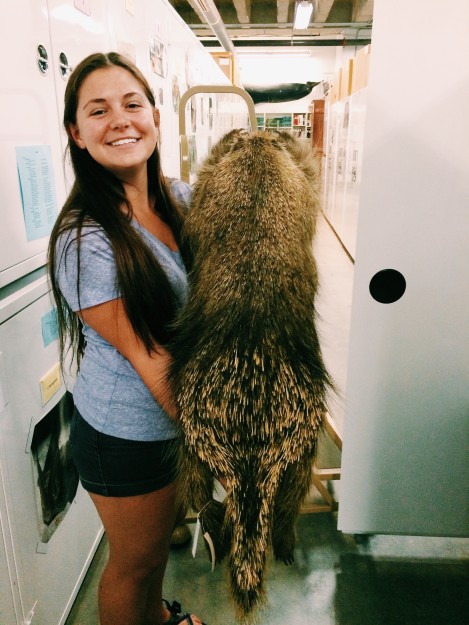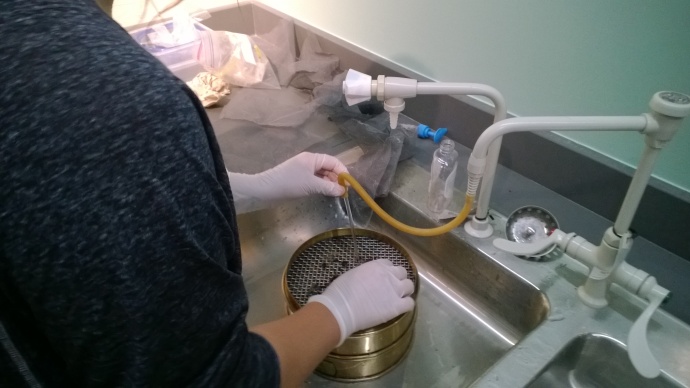Over the past six months I have cleaned and analyzed over 400 samples of fisher scat that had been collected during trapping events, den trees and walkins from 2009 to 2013. While being a scat analyst has not been the most glamorous job, I found the work to be extremely interesting as well as informative. I completed this work in the Biodiversity Lab at the North Carolina Museum of Natural Science’s Nature Research Center (special thanks to Roland Kays). Before I was able to start going through the samples, I had to create a reference collection of animals that were likely a part of a fisher’s diet potential prey animals (like porcupines – see picture).

Porcupines – making people happy
This gave me the opportunity to explore the full collection of mammals at the museum and take hair samples from those species. With these samples I made slides that demonstrated the cuticle and medulla for each species.
This allowed me to compare hairs found within the scat samples to hairs from known samples of identified animals. In order to identify what the fishers had eaten, I first had to clean the samples. The washing machine in the lab was not able to sufficient to separate and clean the samples so I had to clean each one manually. The rest of the lab was not very fond of cleaning days; as you can imagine opening and handling scat that had been frozen for a year or longer does not smell like flowers. I had two metal wash drums with different sized grates and a soft fine mesh lining in a sink with a tube attached to the faucet. For each sample I would place 90% of the scat onto the first drum and leave the remaining in the bag to be used for hormone analysis. From there I would run water over the sample to filter it through the grates and clean all the feces off of it.

Washing samples
Remaining particles that couldn’t pass through the drum would be moved onto a plate and I would repeat the process on the second drum and then again on the fine mesh. Once a sample had been completely cleaned and all the remaining particles were separated onto a labeled plate it was put into a dryer. After about a day the samples would be dry and the analysis began. Hair identification can be a grueling but fun process. Species within the same family, for example squirrels (Sciuridae), all have very similar medulla and cuticle patterns. Therefore, it is important to be able to identify the small differences. For instance, normal guard hairs for the western Gray Squirrel (Sciurus griseus) are black with a single white band near the center of the shaft with significant kinks throughout, whereas the hair for the California ground squirrel (Spermophilus beechyi) is black with a single white band slightly closer to the tip and less kinks. If I was not able to identify a hair by using a dissecting microscope I would create a slide with the unknown hair and place it under the compound microscope to see and compare the cuticle scale pattern and medulla pattern within the hair. Along with hair identification I was able to determine a prey species by remnants of tooth and bone as well as scales, feathers, or exoskeleton. Most often I found evidence of various species of rodents (especially squirrels), but there were other interesting things fishers ate. For example, one fisher in particular had consumed common wasps (Vespula vulgaris) on multiple occasions. These samples were very intriguing since the wasps were still in tact.
he data I compiled will be used to continue learning more about the diet of fishers and hopefully identify habitats with available prey.
~Kyra Pruitt currently attends NCSU and serves as one of the many excellent technicians doing great work on the fisher translocation project.







